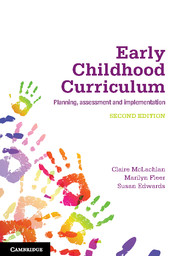Book contents
- Frontmatter
- Contents
- About the authors
- Acknowledgements
- 1 Introduction
- 2 Theory, research and the early childhood curriculum
- 3 Development and learning – how views of development shape how curriculum is framed
- 4 Curriculum as a cultural broker
- 5 Interpreting early childhood curriculum
- 6 Cultural-historical curriculum in action
- 7 Curriculum as a conceptual tool: Observation, content and programming
- 8 Assessing children and evaluating curriculum
- 9 Content knowledge: The sciences, maths and numeracy
- 10 Content knowledge: Language, literacy and ICT
- 11 Content knowledge: The arts and health, wellbeing and physical activity
- 12 Conclusions
- Glossary
- References
- Index
9 - Content knowledge: The sciences, maths and numeracy
- Frontmatter
- Contents
- About the authors
- Acknowledgements
- 1 Introduction
- 2 Theory, research and the early childhood curriculum
- 3 Development and learning – how views of development shape how curriculum is framed
- 4 Curriculum as a cultural broker
- 5 Interpreting early childhood curriculum
- 6 Cultural-historical curriculum in action
- 7 Curriculum as a conceptual tool: Observation, content and programming
- 8 Assessing children and evaluating curriculum
- 9 Content knowledge: The sciences, maths and numeracy
- 10 Content knowledge: Language, literacy and ICT
- 11 Content knowledge: The arts and health, wellbeing and physical activity
- 12 Conclusions
- Glossary
- References
- Index
Summary
Learning intentions
This chapter is intended to help you learn that:
Conceptual development of infants and toddlers must be planned for and key concepts are found in most early childhood curricula.
Concepts in science, mathematics and sustainability are important for infants and young children to learn.
Everyday concepts and academic concepts must both be supported in the early childhood learning environment.
In this chapter the theory and the practice of Vygotsky’s (1987b) work on concept formation will be introduced. This work is important for framing approaches to building content knowledge in mathematics and science in the context of the environment. This is an important part of the early childhood curriculum that can sometimes get lost in play-based approaches. In this chapter, a model for understanding how concept formation occurs in relation to children’s everyday experiences of the world and their acquisition of formal knowledge will be examined. The model is explained using examples from practice which show how children and teachers can work together to build conceptual knowledge within play-based approaches to curriculum.
- Type
- Chapter
- Information
- Early Childhood CurriculumPlanning, Assessment, and Implementation, pp. 141 - 160Publisher: Cambridge University PressPrint publication year: 2013



